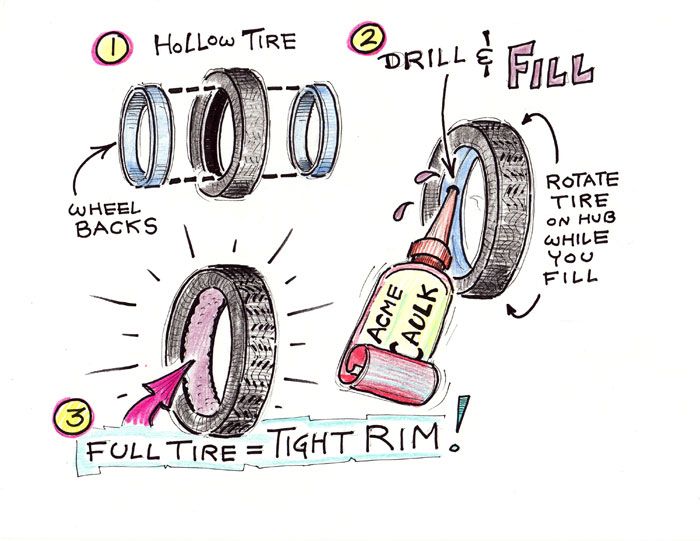By Wayne Scraba,www.automedia.com
Rotating tires is important (and always has been) for car maintenance. If you rotate the respective wheels and tires on a given axle, tire wear is even. The result is almost always balanced traction and handling over a period of time. Most tire warranties demand the tires be rotated on a specific mileage schedule. And many tire manufacturers recommend rotation at between 3,000 and 5,000 miles.
Tire balancing
Making each tire function in as many of the vehicle’s wheel positions as possible makes evening out tire wear feasible. Naturally, this can’t make up for tire wear caused by tired or malfunctioning mechanical components or improper inflation. When considering the mechanics of a motor vehicle, keep in mind that the front end often has a more difficult task than the rear. For example, in a front-wheel-drive car, the tires are tasked with steering, stopping, moving up and down, and, of course, pulling the vehicle forward.
In a high-performance rear-wheel-drive car, you’ll likely find that the rear tires take more abuse than the front. Four-by-four vehicles and all-wheel-drive models bring their own tire wear peculiarities to the party. The bottom line: No matter what the car or truck, the wheel position can cause different rates and types of wear on a tire.
Replacing four versus two
As a tire wears, the tread depth is reduced. If all four tires wear out at more or less the same time, you can replace four tires at once. This is actually advantageous when compared to replacing tires in pairs, simply because you’ll always have equal fresh rubber on all four corners. Additionally, you have to consider that the manufacturers are constantly releasing new and improved tire configurations. The result is that your old tires could become obsolete by the time they’re worn. If replacing only two at once, there’s a good chance you’ll end up with mixed tire technology that could negatively affect how your vehicle drives.
Tire rotation pattern
So far so good, but tire rotation isn’t anything like it was a few decades ago. Way back when, most cars had identical wheels and tires on all four corners, and the spare was also a full-size job that matched the road wheels. That’s a difficult combination to find today, with space-saver spares, spare tires mounted on dedicated steel wheels (with the rest of the rolling stock on aluminum wheels), different wheel offsets and sizes front and rear, mixed tire sizes, and so on. Because of this, the rotation process differs. Here’s a look at some of the many different tire rotation pattern options.
Four same-size tires, non-directional
If the tires are non-directional and the tires and wheels are all the same size, there are three different four-tire rotation patterns most commonly used:
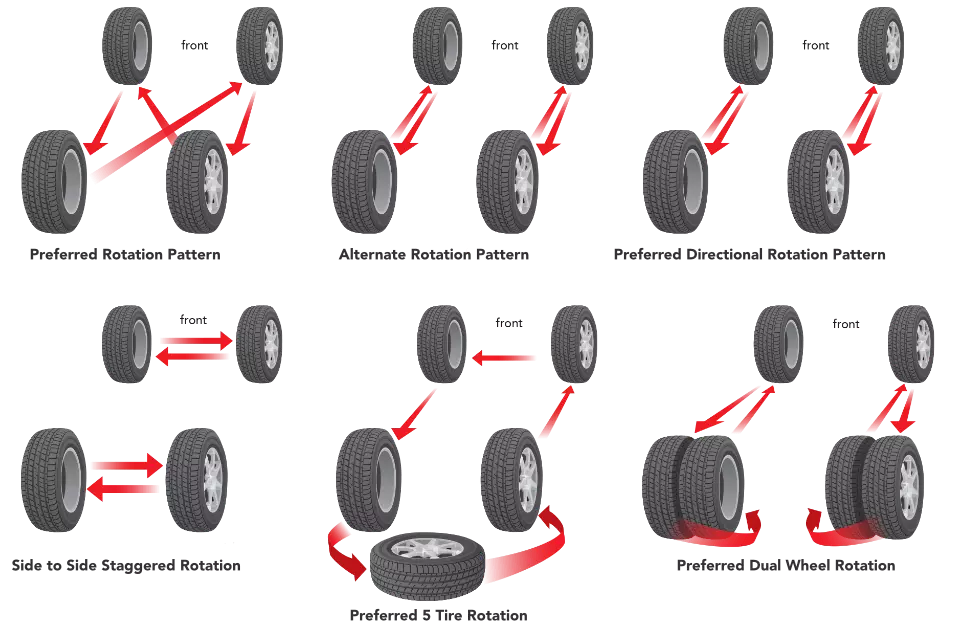 The left rear goes to the right front and the right rear goes to the left front.
The left rear goes to the right front and the right rear goes to the left front.Different-size directional tires, or different offsets
What if the vehicle in question has different-size directional wheels and tires or is equipped with wheels with different offsets (wheel backspace) front and rear? In this case, the tires will definitely require dismounting, remounting and rebalancing in order to rotate the tires. Four other typical rotation patterns are as follows:
 The left rear goes to left front. The right front goes to the right rear. The right rear goes to the right front.
The left rear goes to left front. The right front goes to the right rear. The right rear goes to the right front.
Front-wheel drive : The left front goes to the left rear. The left rear goes to the right front. The right rear goes to the left front. The spare goes to the right rear. The right front goes to the spare.
The left rear goes to the right front. The right rear goes to the left front. The spare goes to the right rear. The right front goes to the spare.
Rear-wheel drive or four-wheel drive: The left rear goes to the left front. The left front goes to the spare. The spare goes to the right rear. The right rear goes to the right front. The right front goes to the left rear.
The idea here is to distribute the wear over five tires throughout their life. This is particularly important on many all-wheel-drive vehicles in that all tires, including the spare, are, in theory, worn identically.
Tire rotation, that is routinely repositioning your vehicle’s tires in specific patterns from front to back or side to side, is an important element of tire upkeep and safety. Additionally, rotating your tires may also be required to keep your tires covered under warranty. For a quick visual summary of tire rotation, check out our Tread Life episode about tire rotation. Read on for more information about what tire rotation is, why tire rotation patterns matter, and the correct pattern for your vehicle’s needs.
Read on for more information about what tire rotation is, why tire rotation patterns matter, and the correct pattern for your vehicle’s needs.
Find Your Bridgestone Service Center
Tire rotation means periodically changing the position of each of the tires on your vehicle. You should rotate your tires as recommended by the vehicle manufacturer, or every 5,000 miles. For many of you, that will mean when you get your vehicle’s oil changed.
Regularly rotating your tires also gives you a good opportunity to visually inspect them for damage, check their air pressure, have them rebalanced if you’re noticing any vibration, and check their tread depth.
There are several reasons why tire rotation is an important element of your standard tire care. First, by routinely rotating your tires, wear is spread evenly across all four tires, and their tread life is maximized. That’s because each specific position on your vehicle requires a different give from each tire—(for example, tires on the front of a front-wheel drive vehicle will take a larger proportion of the torque and friction that’s needed for turning, accelerating and braking)—and can lead to more, or less, wear on the tire. It is especially important to rotate new tires by 5,000 miles because deep, fresh tire tread is more susceptible to uneven wear.
It is especially important to rotate new tires by 5,000 miles because deep, fresh tire tread is more susceptible to uneven wear.
Secondly, even tread wear keeps the tread depth on your tires uniform, which can help keep traction and handling consistent across all four tires. This will improve cornering and braking performance and keep your vehicle safer for driving overall.
Finally, if your vehicle has all-wheel-drive, evenly worn tires lower the stresses on the drivetrain, reducing wear on expensive drive components.
For those looking for a luxury tire experience
See Tire Details This Tire Fits Your Vehicle See a map of stores near you where you can buy this tire
See Tires That Fit Does Not Fit Your Vehicle
See if it Fits Not Sure If This Tire Fits
80,000 miles of quiet, comfort and control*
See Tire Details This Tire Fits Your Vehicle See a map of stores near you where you can buy this tire
See Tires That Fit Does Not Fit Your Vehicle
See if it Fits Not Sure If This Tire Fits
Keep your life on a roll
See Tire Details This Tire Fits Your Vehicle See a map of stores near you where you can buy this tire
See Tires That Fit Does Not Fit Your Vehicle
See if it Fits Not Sure If This Tire Fits
All-season tires that won't stop until they get you there
See Tire Details This Tire Fits Your Vehicle See a map of stores near you where you can buy this tire
See Tires That Fit Does Not Fit Your Vehicle
See if it Fits Not Sure If This Tire Fits
Confident all-weather protection
See Tire Details This Tire Fits Your Vehicle See a map of stores near you where you can buy this tire
See Tires That Fit Does Not Fit Your Vehicle
See if it Fits Not Sure If This Tire Fits
Drive more and fill up your tank less*
See Tire Details This Tire Fits Your Vehicle See a map of stores near you where you can buy this tire
See Tires That Fit Does Not Fit Your Vehicle
See if it Fits Not Sure If This Tire Fits
Extended mobility PLUS improved performance through the elements
See Tire Details This Tire Fits Your Vehicle See a map of stores near you where you can buy this tire
See Tires That Fit Does Not Fit Your Vehicle
See if it Fits Not Sure If This Tire Fits
Built for your truck, SUV, or CUV
See Tire Details This Tire Fits Your Vehicle See a map of stores near you where you can buy this tire
See Tires That Fit Does Not Fit Your Vehicle
See if it Fits Not Sure If This Tire Fits
Tough enough to take a puncture*
See Tire Details This Tire Fits Your Vehicle See a map of stores near you where you can buy this tire
See Tires That Fit Does Not Fit Your Vehicle
See if it Fits Not Sure If This Tire Fits
Tires that take you on a thrill ride
See Tire Details This Tire Fits Your Vehicle See a map of stores near you where you can buy this tire
See Tires That Fit Does Not Fit Your Vehicle
See if it Fits Not Sure If This Tire Fits
Ready for heavy-duty hauls
See Tire Details This Tire Fits Your Vehicle See a map of stores near you where you can buy this tire
See Tires That Fit Does Not Fit Your Vehicle
See if it Fits Not Sure If This Tire Fits
High performance driving all year long
See Tire Details This Tire Fits Your Vehicle See a map of stores near you where you can buy this tire
See Tires That Fit Does Not Fit Your Vehicle
See if it Fits Not Sure If This Tire Fits
Handle it all in your high performance CUV or SUV
See Tire Details This Tire Fits Your Vehicle See a map of stores near you where you can buy this tire
See Tires That Fit Does Not Fit Your Vehicle
See if it Fits Not Sure If This Tire Fits
Ready for the long haul
See Tire Details This Tire Fits Your Vehicle See a map of stores near you where you can buy this tire
See Tires That Fit Does Not Fit Your Vehicle
See if it Fits Not Sure If This Tire Fits
Built to keep you and your workload going
See Tire Details This Tire Fits Your Vehicle See a map of stores near you where you can buy this tire
See Tires That Fit Does Not Fit Your Vehicle
See if it Fits Not Sure If This Tire Fits
Built for the demands of commercial highway driving
See Tire Details This Tire Fits Your Vehicle See a map of stores near you where you can buy this tire
See Tires That Fit Does Not Fit Your Vehicle
See if it Fits Not Sure If This Tire Fits
View All Season Tires
For those looking for a luxury tire experience
See Tire Details This Tire Fits Your Vehicle See a map of stores near you where you can buy this tire
See Tires That Fit Does Not Fit Your Vehicle
See if it Fits Not Sure If This Tire Fits
Keep your life on a roll
See Tire Details This Tire Fits Your Vehicle See a map of stores near you where you can buy this tire
See Tires That Fit Does Not Fit Your Vehicle
See if it Fits Not Sure If This Tire Fits
Built for your truck, SUV, or CUV
See Tire Details This Tire Fits Your Vehicle See a map of stores near you where you can buy this tire
See Tires That Fit Does Not Fit Your Vehicle
See if it Fits Not Sure If This Tire Fits
Take on the intensity of on and off road driving
See Tire Details This Tire Fits Your Vehicle See a map of stores near you where you can buy this tire
See Tires That Fit Does Not Fit Your Vehicle
See if it Fits Not Sure If This Tire Fits
Tires that take you on a thrill ride
See Tire Details This Tire Fits Your Vehicle See a map of stores near you where you can buy this tire
See Tires That Fit Does Not Fit Your Vehicle
See if it Fits Not Sure If This Tire Fits
Ready for heavy-duty hauls
See Tire Details This Tire Fits Your Vehicle See a map of stores near you where you can buy this tire
See Tires That Fit Does Not Fit Your Vehicle
See if it Fits Not Sure If This Tire Fits
Handle it all in your high performance CUV or SUV
See Tire Details This Tire Fits Your Vehicle See a map of stores near you where you can buy this tire
See Tires That Fit Does Not Fit Your Vehicle
See if it Fits Not Sure If This Tire Fits
Next level summer performance for your Sport Truck or SUV
See Tire Details This Tire Fits Your Vehicle See a map of stores near you where you can buy this tire
See Tires That Fit Does Not Fit Your Vehicle
See if it Fits Not Sure If This Tire Fits
Ready for the long haul
See Tire Details This Tire Fits Your Vehicle See a map of stores near you where you can buy this tire
See Tires That Fit Does Not Fit Your Vehicle
See if it Fits Not Sure If This Tire Fits
Built to keep you and your workload going
See Tire Details This Tire Fits Your Vehicle See a map of stores near you where you can buy this tire
See Tires That Fit Does Not Fit Your Vehicle
See if it Fits Not Sure If This Tire Fits
Built for the demands of commercial highway driving
See Tire Details This Tire Fits Your Vehicle See a map of stores near you where you can buy this tire
See Tires That Fit Does Not Fit Your Vehicle
See if it Fits Not Sure If This Tire Fits
View All Light/Medium Truck Tires
For winters worst
See Tire Details This Tire Fits Your Vehicle See a map of stores near you where you can buy this tire
See Tires That Fit Does Not Fit Your Vehicle
See if it Fits Not Sure If This Tire Fits
Luxury takes on winter
See Tire Details This Tire Fits Your Vehicle See a map of stores near you where you can buy this tire
See Tires That Fit Does Not Fit Your Vehicle
See if it Fits Not Sure If This Tire Fits
Impressive grip and control
See Tire Details This Tire Fits Your Vehicle See a map of stores near you where you can buy this tire
See Tires That Fit Does Not Fit Your Vehicle
See if it Fits Not Sure If This Tire Fits
Navigate through snow and ice in your SUV, CUV, or truck
See Tire Details This Tire Fits Your Vehicle See a map of stores near you where you can buy this tire
See Tires That Fit Does Not Fit Your Vehicle
See if it Fits Not Sure If This Tire Fits
Built for blizzards and winters worst in a commerical light truck or van
See Tire Details This Tire Fits Your Vehicle See a map of stores near you where you can buy this tire
See Tires That Fit Does Not Fit Your Vehicle
See if it Fits Not Sure If This Tire Fits
Built to get you through this winter
See Tire Details This Tire Fits Your Vehicle See a map of stores near you where you can buy this tire
See Tires That Fit Does Not Fit Your Vehicle
See if it Fits Not Sure If This Tire Fits
Keep your commercial truck or van in commission all winter
See Tire Details This Tire Fits Your Vehicle See a map of stores near you where you can buy this tire
See Tires That Fit Does Not Fit Your Vehicle
See if it Fits Not Sure If This Tire Fits
View All Winter Tires
Take control of the track
See Tire Details This Tire Fits Your Vehicle See a map of stores near you where you can buy this tire
See Tires That Fit Does Not Fit Your Vehicle
See if it Fits Not Sure If This Tire Fits
Sleek, sporty, and cornering performance
See Tire Details This Tire Fits Your Vehicle See a map of stores near you where you can buy this tire
See Tires That Fit Does Not Fit Your Vehicle
See if it Fits Not Sure If This Tire Fits
Take your sports car for a spin
See Tire Details This Tire Fits Your Vehicle See a map of stores near you where you can buy this tire
See Tires That Fit Does Not Fit Your Vehicle
See if it Fits Not Sure If This Tire Fits
Next level summer performance for your Sport Truck or SUV
See Tire Details This Tire Fits Your Vehicle See a map of stores near you where you can buy this tire
See Tires That Fit Does Not Fit Your Vehicle
See if it Fits Not Sure If This Tire Fits
Feel the rush with tires inspired by racing
See Tire Details This Tire Fits Your Vehicle See a map of stores near you where you can buy this tire
See Tires That Fit Does Not Fit Your Vehicle
See if it Fits Not Sure If This Tire Fits
Chase your competitive spirit
See Tire Details This Tire Fits Your Vehicle See a map of stores near you where you can buy this tire
See Tires That Fit Does Not Fit Your Vehicle
See if it Fits Not Sure If This Tire Fits
View All Summer Tires
For those looking for a luxury tire experience
See Tire Details This Tire Fits Your Vehicle See a map of stores near you where you can buy this tire
See Tires That Fit Does Not Fit Your Vehicle
See if it Fits Not Sure If This Tire Fits
80,000 miles of quiet, comfort and control*
See Tire Details This Tire Fits Your Vehicle See a map of stores near you where you can buy this tire
See Tires That Fit Does Not Fit Your Vehicle
See if it Fits Not Sure If This Tire Fits
Keep your life on a roll
See Tire Details This Tire Fits Your Vehicle See a map of stores near you where you can buy this tire
See Tires That Fit Does Not Fit Your Vehicle
See if it Fits Not Sure If This Tire Fits
All-season tires that won't stop until they get you there
See Tire Details This Tire Fits Your Vehicle See a map of stores near you where you can buy this tire
See Tires That Fit Does Not Fit Your Vehicle
See if it Fits Not Sure If This Tire Fits
Confident all-weather protection
See Tire Details This Tire Fits Your Vehicle See a map of stores near you where you can buy this tire
See Tires That Fit Does Not Fit Your Vehicle
See if it Fits Not Sure If This Tire Fits
Drive more and fill up your tank less*
See Tire Details This Tire Fits Your Vehicle See a map of stores near you where you can buy this tire
See Tires That Fit Does Not Fit Your Vehicle
See if it Fits Not Sure If This Tire Fits
Extended mobility PLUS improved performance through the elements
See Tire Details This Tire Fits Your Vehicle See a map of stores near you where you can buy this tire
See Tires That Fit Does Not Fit Your Vehicle
See if it Fits Not Sure If This Tire Fits
Built for your truck, SUV, or CUV
See Tire Details This Tire Fits Your Vehicle See a map of stores near you where you can buy this tire
See Tires That Fit Does Not Fit Your Vehicle
See if it Fits Not Sure If This Tire Fits
Take on the intensity of on and off road driving
See Tire Details This Tire Fits Your Vehicle See a map of stores near you where you can buy this tire
See Tires That Fit Does Not Fit Your Vehicle
See if it Fits Not Sure If This Tire Fits
Tough enough to take a puncture*
See Tire Details This Tire Fits Your Vehicle See a map of stores near you where you can buy this tire
See Tires That Fit Does Not Fit Your Vehicle
See if it Fits Not Sure If This Tire Fits
Tires that take you on a thrill ride
See Tire Details This Tire Fits Your Vehicle See a map of stores near you where you can buy this tire
See Tires That Fit Does Not Fit Your Vehicle
See if it Fits Not Sure If This Tire Fits
Ready for heavy-duty hauls
See Tire Details This Tire Fits Your Vehicle See a map of stores near you where you can buy this tire
See Tires That Fit Does Not Fit Your Vehicle
See if it Fits Not Sure If This Tire Fits
High performance driving all year long
See Tire Details This Tire Fits Your Vehicle See a map of stores near you where you can buy this tire
See Tires That Fit Does Not Fit Your Vehicle
See if it Fits Not Sure If This Tire Fits
Handle it all in your high performance CUV or SUV
See Tire Details This Tire Fits Your Vehicle See a map of stores near you where you can buy this tire
See Tires That Fit Does Not Fit Your Vehicle
See if it Fits Not Sure If This Tire Fits
Take control of the track
See Tire Details This Tire Fits Your Vehicle See a map of stores near you where you can buy this tire
See Tires That Fit Does Not Fit Your Vehicle
See if it Fits Not Sure If This Tire Fits
Sleek, sporty, and cornering performance
See Tire Details This Tire Fits Your Vehicle See a map of stores near you where you can buy this tire
See Tires That Fit Does Not Fit Your Vehicle
See if it Fits Not Sure If This Tire Fits
Take your sports car for a spin
See Tire Details This Tire Fits Your Vehicle See a map of stores near you where you can buy this tire
See Tires That Fit Does Not Fit Your Vehicle
See if it Fits Not Sure If This Tire Fits
Next level summer performance for your Sport Truck or SUV
See Tire Details This Tire Fits Your Vehicle See a map of stores near you where you can buy this tire
See Tires That Fit Does Not Fit Your Vehicle
See if it Fits Not Sure If This Tire Fits
Feel the rush with tires inspired by racing
See Tire Details This Tire Fits Your Vehicle See a map of stores near you where you can buy this tire
See Tires That Fit Does Not Fit Your Vehicle
See if it Fits Not Sure If This Tire Fits
For winters worst
See Tire Details This Tire Fits Your Vehicle See a map of stores near you where you can buy this tire
See Tires That Fit Does Not Fit Your Vehicle
See if it Fits Not Sure If This Tire Fits
Luxury takes on winter
See Tire Details This Tire Fits Your Vehicle See a map of stores near you where you can buy this tire
See Tires That Fit Does Not Fit Your Vehicle
See if it Fits Not Sure If This Tire Fits
Chase your competitive spirit
See Tire Details This Tire Fits Your Vehicle See a map of stores near you where you can buy this tire
See Tires That Fit Does Not Fit Your Vehicle
See if it Fits Not Sure If This Tire Fits
Navigate through snow and ice in your SUV, CUV, or truck
See Tire Details This Tire Fits Your Vehicle See a map of stores near you where you can buy this tire
See Tires That Fit Does Not Fit Your Vehicle
See if it Fits Not Sure If This Tire Fits
Impressive grip and control
See Tire Details This Tire Fits Your Vehicle See a map of stores near you where you can buy this tire
See Tires That Fit Does Not Fit Your Vehicle
See if it Fits Not Sure If This Tire Fits
Ready for the long haul
See Tire Details This Tire Fits Your Vehicle See a map of stores near you where you can buy this tire
See Tires That Fit Does Not Fit Your Vehicle
See if it Fits Not Sure If This Tire Fits
Built to keep you and your workload going
See Tire Details This Tire Fits Your Vehicle See a map of stores near you where you can buy this tire
See Tires That Fit Does Not Fit Your Vehicle
See if it Fits Not Sure If This Tire Fits
Built for blizzards and winters worst in a commerical light truck or van
See Tire Details This Tire Fits Your Vehicle See a map of stores near you where you can buy this tire
See Tires That Fit Does Not Fit Your Vehicle
See if it Fits Not Sure If This Tire Fits
Built for the demands of commercial highway driving
See Tire Details This Tire Fits Your Vehicle See a map of stores near you where you can buy this tire
See Tires That Fit Does Not Fit Your Vehicle
See if it Fits Not Sure If This Tire Fits
Built to get you through this winter
See Tire Details This Tire Fits Your Vehicle See a map of stores near you where you can buy this tire
See Tires That Fit Does Not Fit Your Vehicle
See if it Fits Not Sure If This Tire Fits
Keep your commercial truck or van in commission all winter
See Tire Details This Tire Fits Your Vehicle See a map of stores near you where you can buy this tire
See Tires That Fit Does Not Fit Your Vehicle
See if it Fits Not Sure If This Tire Fits
View DriveGuard Tires
The tire rotation pattern that’s best for your vehicle will depend on the type of tire you’re using, whether your vehicle is front, rear, all, or four-wheel drive, whether your tires are directional or non-directional, whether or not your tires are the same size on the front and rear of your vehicle, and whether you have a full-size spare that can be rotated through as well, unlike a temporary spare. . Let’s take a look at tire rotation patterns recommended by the standardizing body of the tire industry, The Tire and Rim Association, Inc., for all of these possibilities.
. Let’s take a look at tire rotation patterns recommended by the standardizing body of the tire industry, The Tire and Rim Association, Inc., for all of these possibilities.
For vehicles that are 4-wheel, all-wheel, or rear-wheel drive, the rearward cross pattern is recommended. Rear tires are moved to the forward axle and kept on the same side of the vehicle while the front tires are moved to opposite sides of the rear axle.
2. X-PATTERNRecommended for front-wheel drive vehicles such as light-weight trucks and sedans, all tires are moved diagonally, meaning tires are switched from one axle to the opposite as well as being repositioned from one side to the other.
3. FORWARD CROSSThis is the most common pattern for front-wheel drive vehicles. The front axle tires are moved directly back while the rear tires are moved up diagonally to the opposite side of the front axle.
In order to insure that all of the tires on your vehicle have even tread wear, you’ll want to be sure to rotate your full-size spare tire along with the other four. This is especially vital for all-wheel or 4-wheel drive vehicles where even small differences can put undue strain on your car’s drive train.
1. REARWARD CROSS (REAR-WHEEL OR 4-WHEEL DRIVE VEHICLES):Both rear axle tires move directly forward to the front axle while the spare tire moves to the right side of the rear axle. The right front tire moves diagonally back to the left side of the rear axle while the left front tire becomes your new spare tire.
2. FORWARD CROSS (FRONT-WHEEL DRIVE VEHICLES):Rear tires are moved diagonally to opposite sides on the front axle while the right front tire becomes the new spare tire. The spare tire is positioned on the right side of the rear axle while the left tire on the front axle is moved directly back into the left rear position.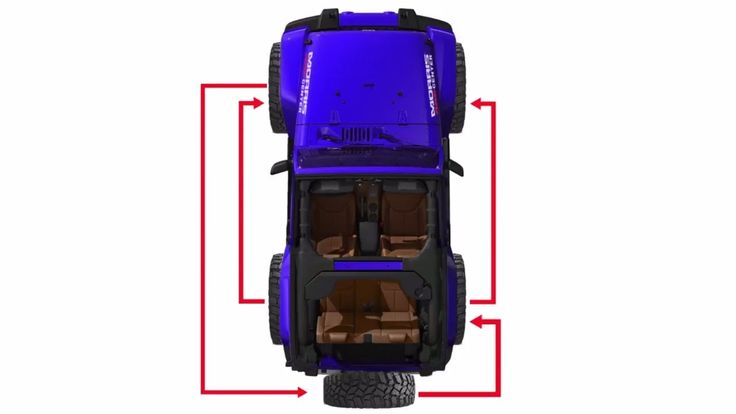
All tires are switched with their same-sized partner and remain on the same axle. The two rear tires switch to the opposite side with one another while the two front tires do the same.
2. FRONT-TO-BACK (FOR DIRECTIONAL TIRES)All tires are moved from one axle to the other but remain on the same side of the vehicle. For example, the front left tire is moved to the left side of the rear axle while the rear left tire is repositioned on the left side of the front axle.
Tire swapping involves switching tires from wheel to wheel in a specific pattern. Although some drivers never take it seriously, it is necessary for optimum tire condition.
Since each car tire performs different tasks and wears differently, changing positions helps even out wear.
So, for example, let's discuss the details of changing tires in front wheel drive vehicles. nine0003
Tire swaps on front-wheel drive vehicles can't be random. The most common method in the industry is the direct intersection method. There are other ways to swap tires, but this one is most effective for front-wheel drive vehicles. You can check the user manual for more details.
Like any other vehicle, front wheel drive (FWD) tires need to be changed. Vehicles equipped with this transmission transfer significant engine power to the front wheels.
In FWD, the front wheels practically pull the vehicle forward and are also responsible for the direction of all vehicles. With such loads on the front wheels, they wear out faster.
Due to the stress they are under, replacing them with rear ones will extend their life.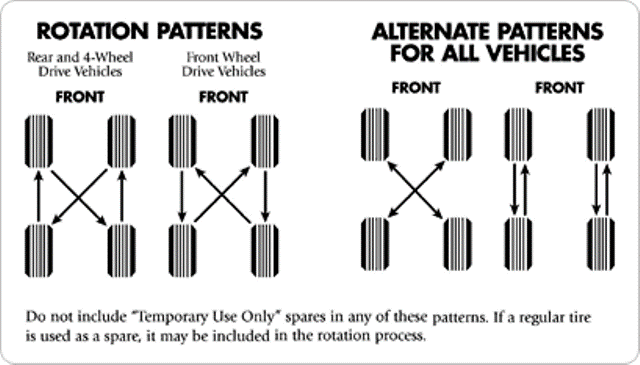 This also ensures that all four tires wear evenly and that the entire set can be replaced at once. nine0003
This also ensures that all four tires wear evenly and that the entire set can be replaced at once. nine0003
You must rotate all tires on your front wheel drive vehicle in a specific pattern or as recommended in your owner's manual. The most common pattern is the straight cross pattern.
Here the left rear wheel intersects with the front right axle. Then the rear right axle goes to the front left axle. The front right and front left tires go to the rear axle without crossing. nine0003
For directional tires, the rotation pattern must be strictly front to back and back to front without crossing. This means that the tires on the front axle are swapped with the tires on the rear axle without crossing sides. The reason is that the direction of the tread will not be changed.
Directional tires only move in one direction and crossing them defeats that purpose.
Front wheel drive can be very different from all wheel drive. The recommended layout for this type of transmission is a rear cross or X-pattern. nine0003
The recommended layout for this type of transmission is a rear cross or X-pattern. nine0003
Rear transverse pattern moves the rear tires towards the front axle without crossing. In the case of the front tires, they intersect with the rear axle. This is the complete opposite of the straight cross pattern.
The X pattern technique involves crossing all tires diagonally to the other side.
The way you turn your tires has a significant impact on the performance of your vehicle. For example, if you do it right, you will get a smoother ride. nine0003
It also makes vehicles safer on the road by improving cornering and handling.
If you neglect to rotate the tires for too long, they may burst. This is because few tires will be subjected to excessive stress over time. Even distribution of load and wear across all tires (including the spare) helps prevent this.
Different tires also require different rotation patterns for optimum performance. For example, tire types are mostly symmetrical, asymmetrical, and directional. You can rotate symmetrical and asymmetrical tires using the normal rotation patterns we have explained. nine0006
For example, tire types are mostly symmetrical, asymmetrical, and directional. You can rotate symmetrical and asymmetrical tires using the normal rotation patterns we have explained. nine0006
However, directional tires are designed to provide better grip when driving in a certain direction. Thus, the tires on the right side of the car cannot work properly on the left side, and vice versa. So they don't go both ways.
When properly installed, tires dissipate water for excellent hydroplaning resistance. During the rotation, you will feel the traction loosen and the stopping distance will increase if you cross them.
The recommended intervals for any vehicle can be found in the owner's manual.
However, Edmunds recommends changing tires "every 5,000 to 10,000 miles". Consumer Reports recommends changing them every 8,000 to 8,000 miles. However, this may depend on your driving style.
Tires can also be changed for service or oil change. However, if you adopt this method, make sure you change your oil regularly.
When you accept the recommended rotation interval, each tire spends the same amount of time on each axle. That's how important rotation intervals are. If you use inconsistent clearances, your tires will wear unevenly. nine0003
Despite the recommended intervals, other reasons may cause you to rotate them prematurely. These factors may include transporting heavy loads over long distances.
This increases the load on the tires and causes them to wear faster. That is why you will need to rotate more frequently.
Changing tires is not as difficult as it sounds and you can do it yourself with a few tools. nine0003
You need enough space and time, and you're fine. No tire specialist required. Think of a tire swap like changing a spare tire, only this time it's all of your tires.
In addition, checking the user manual is very important and gives you more confidence. Here are a few tips to keep in mind:
When you put two new tires on a front wheel drive car, they must be put on the rear axle.
This practice is because the rear tires keep the car stable. This will also ensure better vehicle contact with the road. This improves handling on slippery terrain. nine0003
When new tires are fitted to the front axle, excellent wet handling is not guaranteed.
When changing tires, replace all four tires at once for best performance. However, circumstances (such as a burst or bad pressure) can affect your schedule and force you to change a pair of tires.![]()
So what if you only change one tire? In this case, pair it with the rear tire with the deepest tread depth.
Despite regular tire rotation, all tires wear out over time and need to be replaced. For the best time to change tires, refer to your owner's manual for recommended mileage. When the tread wears out, its performance deteriorates and you have to go to the store.
However, whatever you do, please do not use the tire for more than six years after it was made. This is independent of tread depth.
It is advisable to change the entire set at one time. Tire manufacturers are constantly improving their tires, so you get a complete set by replacing them all. nine0003
New tires can be expensive to replace, so maintaining old ones is very cost effective. Tire maintenance goes beyond the rotation we just covered, and the following can help increase tread life.
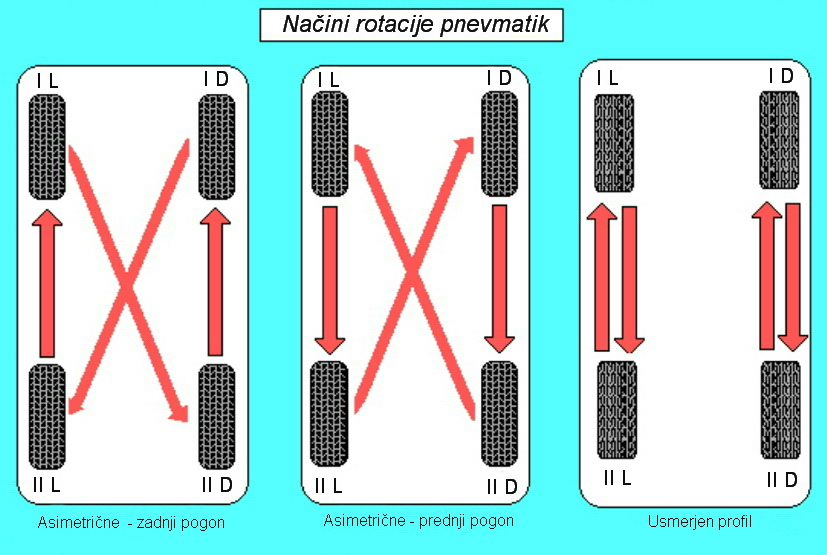 This is where you're looking for cracks, bulges, or cuts that could affect the tire's integrity. These factors can lead to tire failure. nine0088
This is where you're looking for cracks, bulges, or cuts that could affect the tire's integrity. These factors can lead to tire failure. nine0088 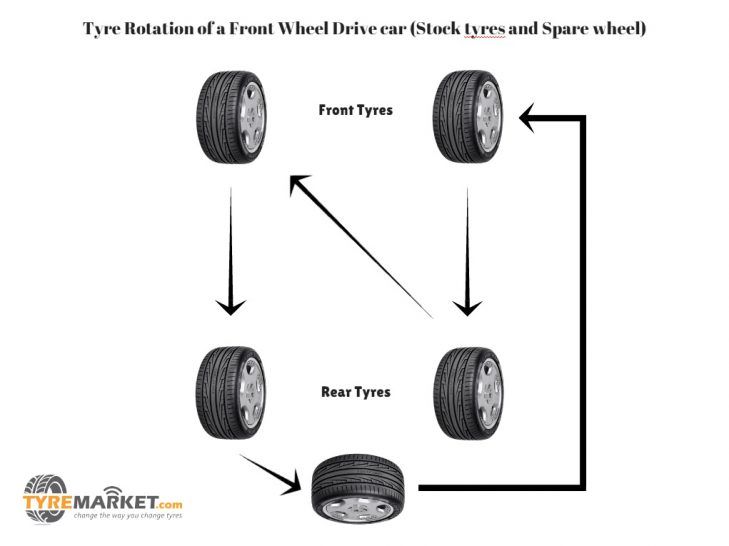
The spare wheel should not be left out of your rotation cycle. This is because you cannot use it after the expiration date, no matter how new it looks. Therefore, to get the most out of your spare tire, you need to add it to your tire rotation. nine0003
This practice also helps increase the tread life of all your tires.
However, if you are using a temporary spare, commonly referred to as a donut, this is not necessary. Donuts are smaller than full size stocks and have fewer features.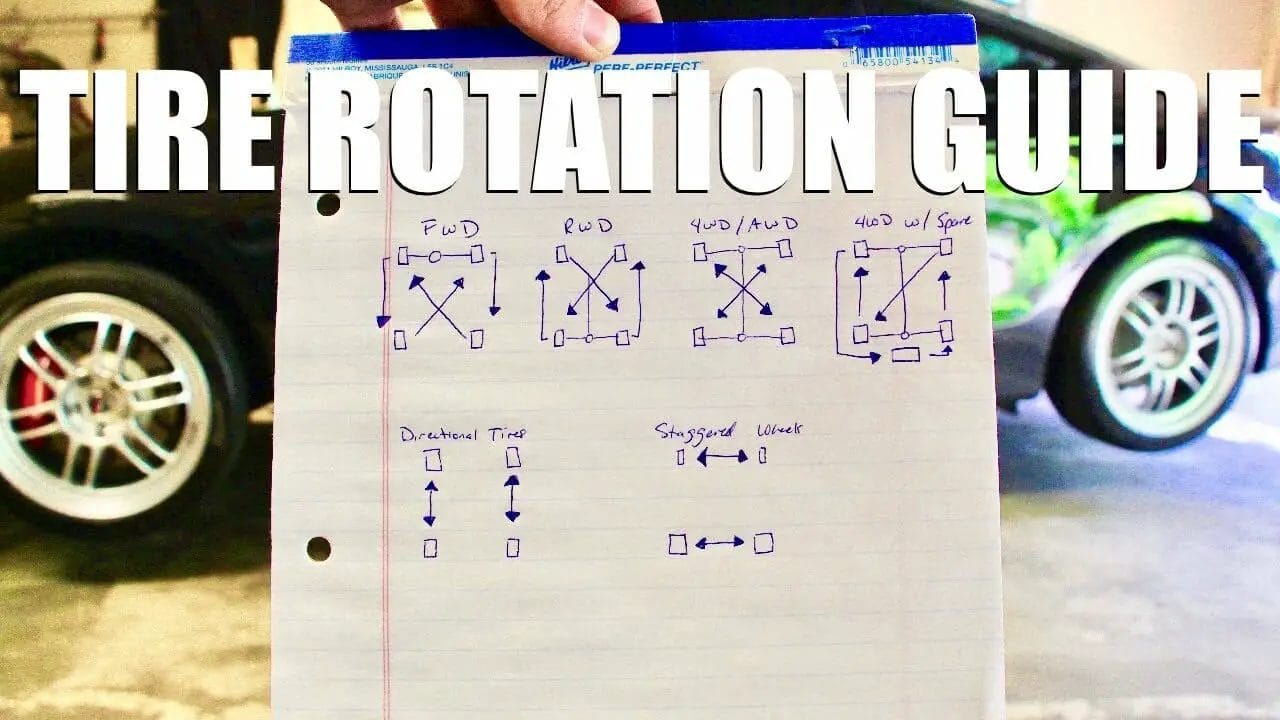 They are intended solely for use in the event of a puncture or rupture.
They are intended solely for use in the event of a puncture or rupture.
Ultimately, be sure to refer to your vehicle owner's manual, no matter what advice you get. nine0003
How to balance motorcycle tires
If you are changing your tires, you will probably also be wondering how to balance them, and this article will help you with this. As with tire installation, balancing is easy to do with a minimum of tools. I'll look at a technique known as "static balancing" that relies on gravity to find a heavy spot on your wheel. nine0003
Most people are more familiar with another balancing method called "dynamic balancing" which uses the machine to rotate the tire at high speeds to determine balance. Unless you're planning on opening a tire shop, you probably don't want to spend money on a dynamic balancer to replace your own tires.
Static balancer requires a frame and a horizontal shaft to rotate the wheel.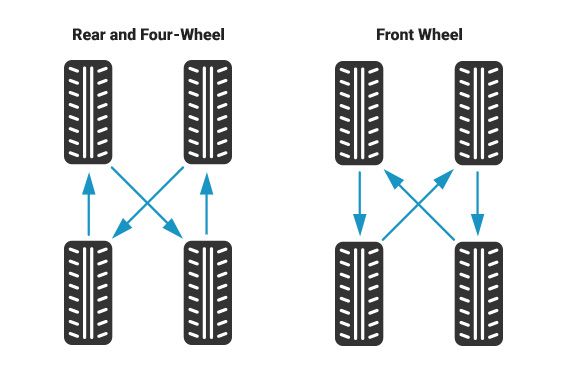 If you like doing light rigging, you can certainly create one and can even use your axle for a perfect fit. For everyone else, you can buy a factory stand. nine0003
If you like doing light rigging, you can certainly create one and can even use your axle for a perfect fit. For everyone else, you can buy a factory stand. nine0003
These factory struts are made "universally shaped" using a small diameter shaft with two cones that fit into an axle hub on either side of the wheel. Once the cones are locked onto the shaft with a set screw, the wheel is centered on the shaft and is ready for balancing.
Normally, motorcycle wheel balancing is carried out only after installing new tires : motokvartal.com.ua/tsepi-privodnye. I'm assuming that you already have a motorcycle wheel and go straight to balancing. nine0003
Step 1: Make sure your balancer sits on a stable surface and the shaft is level. The standard 9" magnetic level makes this process much easier.
Step 2: Remove one of the cones from the balancer shaft before passing the shaft through the axle hub on the wheel. Then slide the cone back onto the shaft (narrow end first) and tighten the set screw firmly to lock it in place. It is important to make sure both cones are seated inside the axle sleeve if the wheel is not centered on the shaft which could affect balance. nine0003
It is important to make sure both cones are seated inside the axle sleeve if the wheel is not centered on the shaft which could affect balance. nine0003
Step 3: Wipe the edges thoroughly with a good degreaser. This is important for two reasons: firstly, you don't want fat drops to throw off your balance, and secondly, if you are using glue weights, then you need to make sure that they hold well. Also, if there are any leftover weights from a previous balance, be sure to remove them.
Step 4: Gently rotate the tire and let it stop on its own. Gravity will cause the tire to stop spinning with the heaviest part at its lowest point. Take a piece of masking tape and mark this point on the rim. If the heaviest part of the wheel is at the lowest point, then keep in mind that the lightest part of the wheel is at the highest point. Therefore, you will add weights to the top of the wheel, directly opposite the heaviest part. Adding a piece of tape makes it easier to remember the location of the heaviest point on the wheel.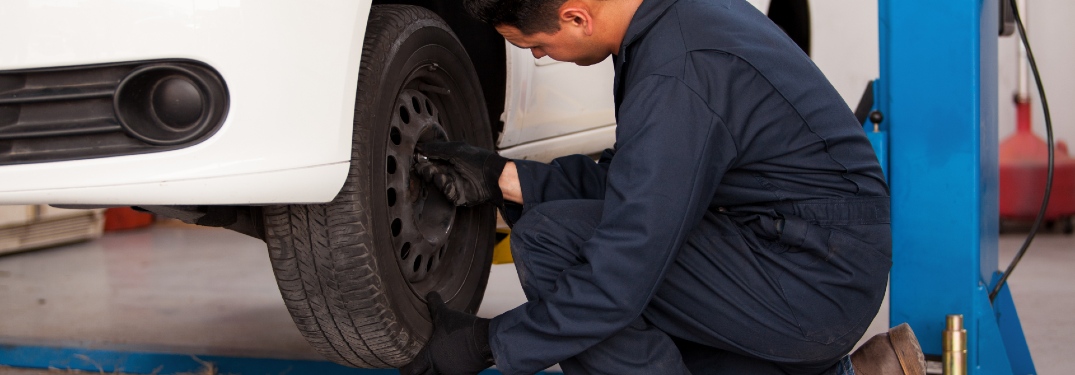 If you are using a non-spoke binding, the best option for the weights is an adhesive that simply sticks to the rim. They are cheap and easy to use and allow you to distribute the weight on both sides of the rim. If you are using a spoked rim, you also have the option of using spokes with spoke pressure or holding onto the spoke with a set screw. They are generally more expensive than adhesive-coated scales, but they have the advantage of being reusable and less likely to come off. nine0003
If you are using a non-spoke binding, the best option for the weights is an adhesive that simply sticks to the rim. They are cheap and easy to use and allow you to distribute the weight on both sides of the rim. If you are using a spoked rim, you also have the option of using spokes with spoke pressure or holding onto the spoke with a set screw. They are generally more expensive than adhesive-coated scales, but they have the advantage of being reusable and less likely to come off. nine0003
Step 5: Add a few grams of weight to the lightest part of the tire. If you are using an adhesive scale, use tape to temporarily hold it in place. Adhesive lifted weights come in strips that can be cut to achieve your desired weight. The spokes of the weight wheels come in different weights and can be stacked if needed.
Step 6: Rotate the tire until the lightest part and the heaviest part are equidistant from the running surface, and carefully release the wheel. Again the wheel will naturally rotate to a position where the heaviest part is at its lowest point. Typically, this will be the same item that you originally determined for the heaviest part of the wheel, which means you need to add more weight to the lightest part. Alternatively, if the part you just added weight to is now at its lowest point, then you have added too much weight and should be removed. Use double-sided tape or masking tape to temporarily hold the scale in place during this process. nine0003
Again the wheel will naturally rotate to a position where the heaviest part is at its lowest point. Typically, this will be the same item that you originally determined for the heaviest part of the wheel, which means you need to add more weight to the lightest part. Alternatively, if the part you just added weight to is now at its lowest point, then you have added too much weight and should be removed. Use double-sided tape or masking tape to temporarily hold the scale in place during this process. nine0003
Step 7: Continue repeating step 6 until the wheel spins spontaneously when released. A properly balanced tire should remain stationary when released, as there is no heavier part to spin the wheel. When you think you've got your balance right, try turning and releasing the wheel at the 12:00, 3:00, 6:00, and 9:00 positions.
Step 8: If you are using spoke weights, you can remove them from the balancer after you finish balancing the wheel.